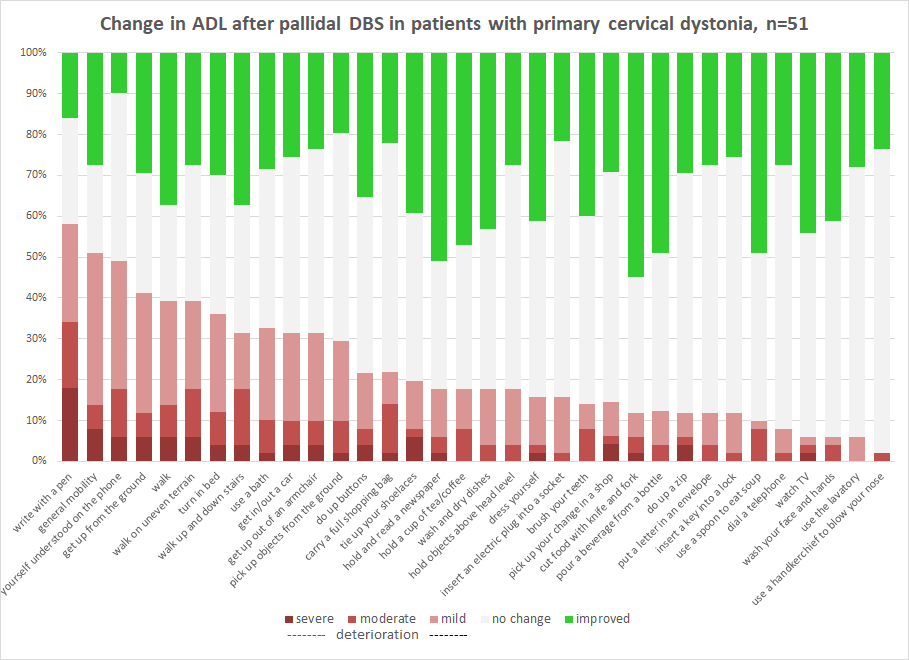Session Information
Date: Wednesday, September 25, 2019
Session Title: Surgical Therapy
Session Time: 1:15pm-2:45pm
Location: Les Muses Terrace, Level 3
Objective: To assess the impact of pallidal deep brain stimulation (DBS) on activities of daily living (ADL) in patients with primary craniocervical dystonia (CD).
Background: Pallidal DBS is an effective treatment option for severe CD when botulinumtoxine treatment has failed. Dysarthria has been described as a common side effect of pallidal stimulation in generalized dystonia. However, only in patients with focal dystonia it has been recognized that mild bradykinesia up to full parkinsonian phenotype may occur with chronic pallidal DBS.
Method: We conducted a multi-center survey in a cohort of 51 patients (mean age 58±10) with primary CD who underwent pallidal DBS with stable stimulation parameters for at least 3 months. The survey included a questionnaire with 34 items of ADL. Patients were asked to rate subjective changes in ADL compared to the pre-operative state based on a 5-point-Likert-scale (improved; no change; mild, moderate or severe deterioration). Furthermore, a rating of an overall post-operative improvement of dystonia was assessed via a visual analogue scale.
Results: Patients reported a mean subjective improvement of dystonia by 62% (±26) with pallidal DBS. ADL improvement was reached on average in 11 out of 34 items, whereas a mean of 8 items deteriorated in a range from mild to severe. Among the top3 ADL items, which improved most consistently were ‘cut food with knife and fork’ (55%), ‘hold and read a newspaper’ (51%), ‘use a spoon to eat a soup’ (49%). On the other hand, activities which deteriorated post-operatively included ‘handwriting’ (58%), ‘general mobility’ (51%) and ‘speaking loud and clearly on the phone’ (49%), [figure1]. Worsening in ADL items related to bradykinesia (17 out of 34 items) was mentioned by 80% of patients, again from mild to severe.
Conclusion: Our results emphasize that despite an overall functionally meaningful improvement in dystonia by pallidal DBS certain ADL that require fine motor skills can deteriorate post-operatively. Bradykinesia should be discussed as a potential side effect when counseling patients before DBS surgery. It will be important to evaluate to which extent stimulation parameters and even more importantly electrode location contribute to these side effects.
To cite this abstract in AMA style:
J. Huebl, T. Andermann, C. Blahak, J. Krauss, M. Südmeyer, J. Volkmann, K. Bötzel, A. Wolters, A. Kühn. Impact of pallidal deep brain stimulation on activities of daily living in patients with craniocervical dystonia – a multi-center survey [abstract]. Mov Disord. 2019; 34 (suppl 2). https://www.mdsabstracts.org/abstract/impact-of-pallidal-deep-brain-stimulation-on-activities-of-daily-living-in-patients-with-craniocervical-dystonia-a-multi-center-survey/. Accessed December 19, 2025.« Back to 2019 International Congress
MDS Abstracts - https://www.mdsabstracts.org/abstract/impact-of-pallidal-deep-brain-stimulation-on-activities-of-daily-living-in-patients-with-craniocervical-dystonia-a-multi-center-survey/

